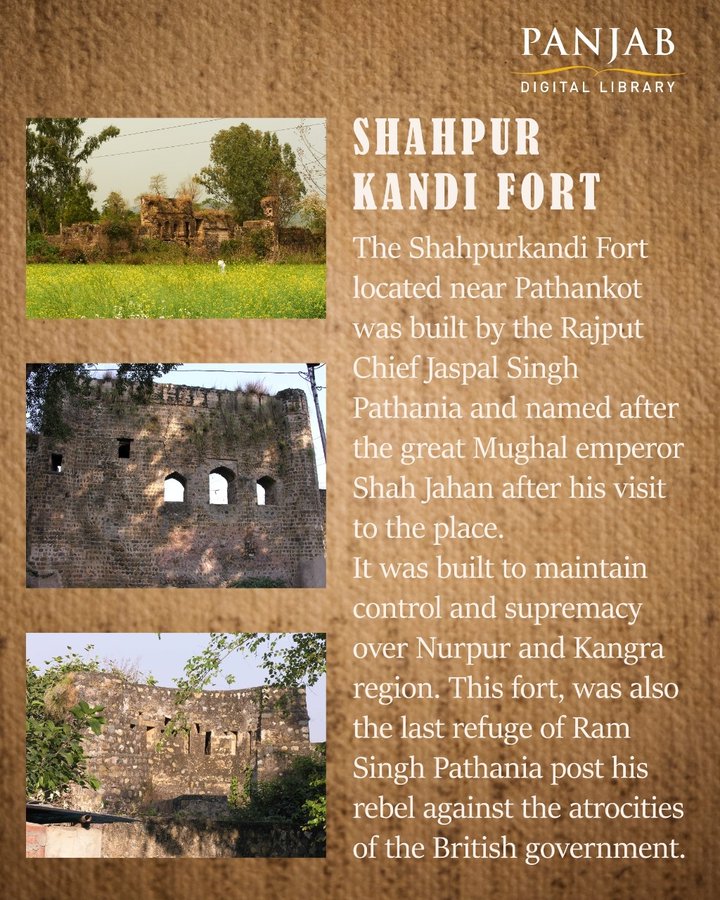Pathankot.
A sleepy border town today.
A land of bravehearts, and more renowned for a terror attack on the air base in 2016.
Yet, there was once a history of Pathankot that few remember in public memory today. Especially of Shahpur Kandi.
Shahpur Kandi is a Fort that falls in Punjab today. It used to be part of the premise of the Nurpur princely state. Nurpur was ruled by the Pathanias, a dynasty that was known as much for bravery and wit as it was for its patronage of art, patronizing the Nurpur shaili of Pahari paintings.
Yet, at least nine years before the Indian war for Independence that took place in 1857, an uprising shook the British East India Company to its core.
It was 1848, and Ram Singh Pathania, who was going incognito post the collapse of the Lahore Durbar, had decided to repatriate himself with his father Sham Singh Pathania to Nurpur. Taking the title of Wazir there, these supposedly minor officials of the Lahore Durbar however had greater plans.
Sham Singh, the father, had been the minister of Raja Veer Singh in the state of Nurpur. As it was, the 1846 British-Sikh Convention in 1846 had meant that most of the princely states of Himachal Pradesh were under the British Empire.
That year, King Veer Singh died. At that time his son Javsant Singh was the successor of the throne. However, the British decreed otherwise, especially with respect to the people mostly in the Darbar of Lahore barring Gulab Singh of Jammu. The treaty following the First Anglo Sikh War and the subsequent negotiations had meant that instead of getting to be part of Jammu riyasat of Gulab Singh, the British had decided to take Nurpur for themselves. As Balraj Madhok had written about the Treaty of Amritsar:
“The amount to be paid was reduced to Rs. 75 lakhs from one crore because the British decided to retain in their own hands the territory between the Beas and the Ravi which includes the Kangra district of the Punjab because of the strategic value of Nurpur and Kangra forts.”
Jaswant Singh, the man who was supposed to succeed, was not the King, while Veer Singh had passed away even before the Treaty was signed on 9 March 1846. This gave the British the opportunity to take away all the rights of Jaswant Singh. To be fair, there was some sympathy towards Jaswant Singh and his step mother, who was from Chamba, and a decent pension ‘suitable to stature’ was considered by the Trans Satluj state commissioner and the Governor General. However, given that Sham Singh and Ram Singh had come back, there was an attempt, given their association with the Lahore Durbar, to keep Jaswant Singh away from Nurpur, lest some effort be made to ‘use him as a rouse’ to stoke a rebellion by the father-son duo. As a result, every effort was made, even forcing nuptial ties with a small riyasat in Shimla, to keep him away.
 |
| Maharani Jind Kaur (courtesy: The Tribune) |
In this process of the Anglo Sikh war, the opportune moment was seized, and Jaswant Singh seized the throne and declared independence, for which the nagada or the drum was personally beaten by Wazir Ram Singh Pathania. Jaswant Singh joined forces with the Katoch Rajputs and made a call against the British. The British were forced to part with Nurpur, as Ram Singh waved his flag.
 |
| Courtesy: Stamp Digest |
By the month of August, gathering brave Rajput men from Jammu and local areas, Wazir Ram Singh Pathania led a force to cross the Ravi river, and by September attacked the fort of Shahpur Kandi. The battle, which took place on 3 September 1848, saw the Nurpur forces succeeding against the British. However, due to the lack of support and a fierce assault of British troops rushed in from Kangra, he had to retreat on 18 September, and take refuge in the jungles near Nurpur, from where he continued guerilla warfare, and eventually moved towards Gujrat in today’s Pakistan to join forces with Raja Sher Singh.
However, that was not the last of the affairs. In the Battle of Dallah Dhar in 1849, he was up against a heavily armed division of forces rushed in from Jallandhar. However, despite his requests for help to various places, even his own family, few turned up to his aid. Despite his limited means however, a fierce battle was fought taking advantage of the terrain. Much like the battle scene shown in the movie The Last Samurai, the battle eventually saw the forces of Ram Singh whittling down, but not before killing several prominent leaders of the British forces, including Lieutenants John Peel and Daniel Christie. He hid as a sadhu in the hills, and eventually got betrayed, and was captured alive and deported.
While some accounts say he was deported to Singapore, it can be confirmed that he was exiled to Mawlamyaing jail in Martaban Hills of present day Myanmar. To that end, the references quote the correspondence dated 19 November 1856, wherein the Commissioner of Punjab is updated about the death of Wazir Ram Singh on 11 November 1856 in the jail.
 |
| Moulmein Jail in Myamar, 1868 picture (courtesy British Library) |
Such was the impact though that to this day, a Vaar is sung in his name among people. Called Vaar Shaheed Ram Singh Pathania Di, you can check it out here.

Comments
Post a Comment